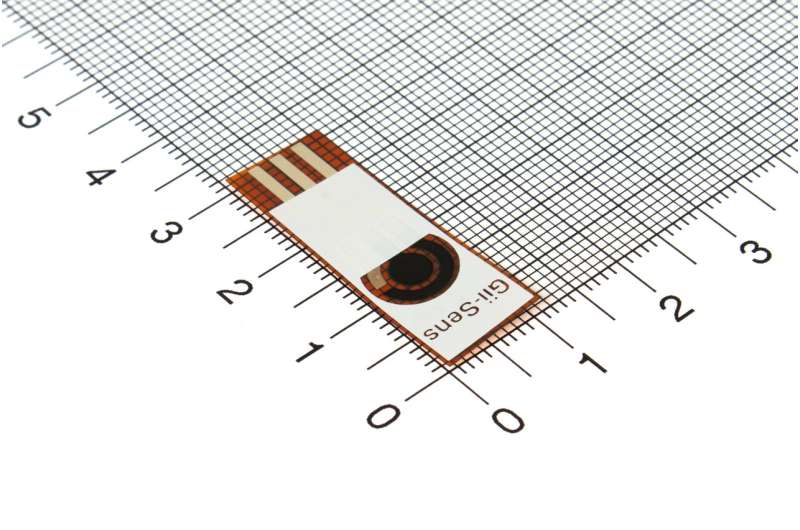This article has been reviewed according to Science X's editorial process and policies. Editors have highlighted the following attributes while ensuring the content's credibility:
fact-checked
peer-reviewed publication
trusted source
proofread
Scientists develop new battery-free lactic acid sensor

Scientists at Bath, have introduced a breakthrough carbon-based sensor for detecting lactic acid levels in saliva—avoiding the need for an electrical power source.
The researchers, working in collaboration with industrial partner, Integrated Graphene, have created a new type of chemosensor (demonstrated for lactic acid sensing) which functions with electricity but without the need for reference electrodes or battery power. The new design potentially offers lower cost, better shelf-life, and ease of miniaturization compared to enzyme-based sensors.
The sensor was proven to detect lactic acid, a by-product generated by the body when it metabolizes carbohydrates or glucose for fuel, for example, during exercise. High levels of lactic acid are linked with higher risks of falling unconscious or into a coma and major organ failure.
This opens up the possibility for an easy-to-use sensor to be used in remote locations, such as an athletics track, without the need for electricity-powered sensing equipment.
Currently, lactic acid is often measured with an enzyme test, which has a limited shelf life and requires battery powered sensing equipment. The new type of chemosensor, detailed in a paper published in ACS Sensors, instead measures lactic acid with a chemical method using a graphene foam electrode surface.
Referenced as "Graphene Foam" in the paper, Gii-Sens, the technology underpinning the chemosensor, is an electrode produced by Integrated Graphene. Gii-Sens incorporates Gii, a pure, porous, 3D carbon nanostructure that delivers low cost and avoids the use of unsustainable noble metals like gold.
When lactate binds to the sensor, it causes a change in the electrical signal—or quantum capacitance—of the carbon foam. The foam therefore detects low levels of lactic acid without consuming it by measuring changes in the electrical charging of Gii, allowing the monitoring of changes in levels. As it is a chemical rather than an enzyme-based sensor, it has a potentially lower cost, better shelf-life, and ease of miniaturization.
Professor Frank Marken, lead author of the study at the University of Bath, said, "Just as your contactless credit card doesn't need an external power source to work because the proximity of the card reader is enough to power it—in a similar way, this sensor could create a small, measurable electrical current when lactate binds to it."
"This sensor, using Gii-Sens technology, addresses some of the main limitations with non-wireless current lactic acid enzyme tests," said Professor Marken, "It will allow for a more simply operated sensor—opening up the potential for more regular, less invasive and more reliable tracking of lactic acid, even during athlete performance."
Lactic acid tests have a number of important applications. In professional sports, lactic acid is tested to assess the athlete's response to different intensities and training regimes. By wirelessly tracking and subsequently improving the body's ability to transport and utilize lactate, athletes aim to improve their endurance and recovery.
It is also used in medical care to track heart conditions like myocardial infarctions, atrial fibrillation, and atherosclerosis. This is useful as elevated lactic acid levels can reduce the heart and blood vessel's ability to contract, impacting the hemodynamics for regular function.
Jean-Christophe Granier, Chief Executive Officer of Integrated Graphene, commented, "This development is another clear use case of Gii-Sens being integrated into sensing products and offering versatile applicability.
"The researcher's test results using our Gii-Sens electrode opens up the possibility of more accessible and reliable health monitoring in remote environments and we look forward to putting our highly sensitive Gii-Sens electrode at the heart of more groundbreaking innovations in the point of care diagnostics market."
More information: Simon M. Wikeley et al, Pyrene-Appended Boronic Acids on Graphene Foam Electrodes Provide Quantum Capacitance-Based Molecular Sensors for Lactate, ACS Sensors (2024). DOI: 10.1021/acssensors.4c00027
Journal information: ACS Sensors
Provided by University of Bath





















